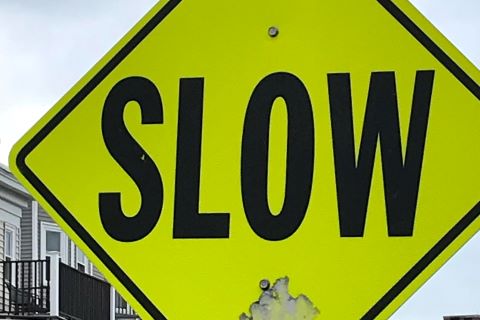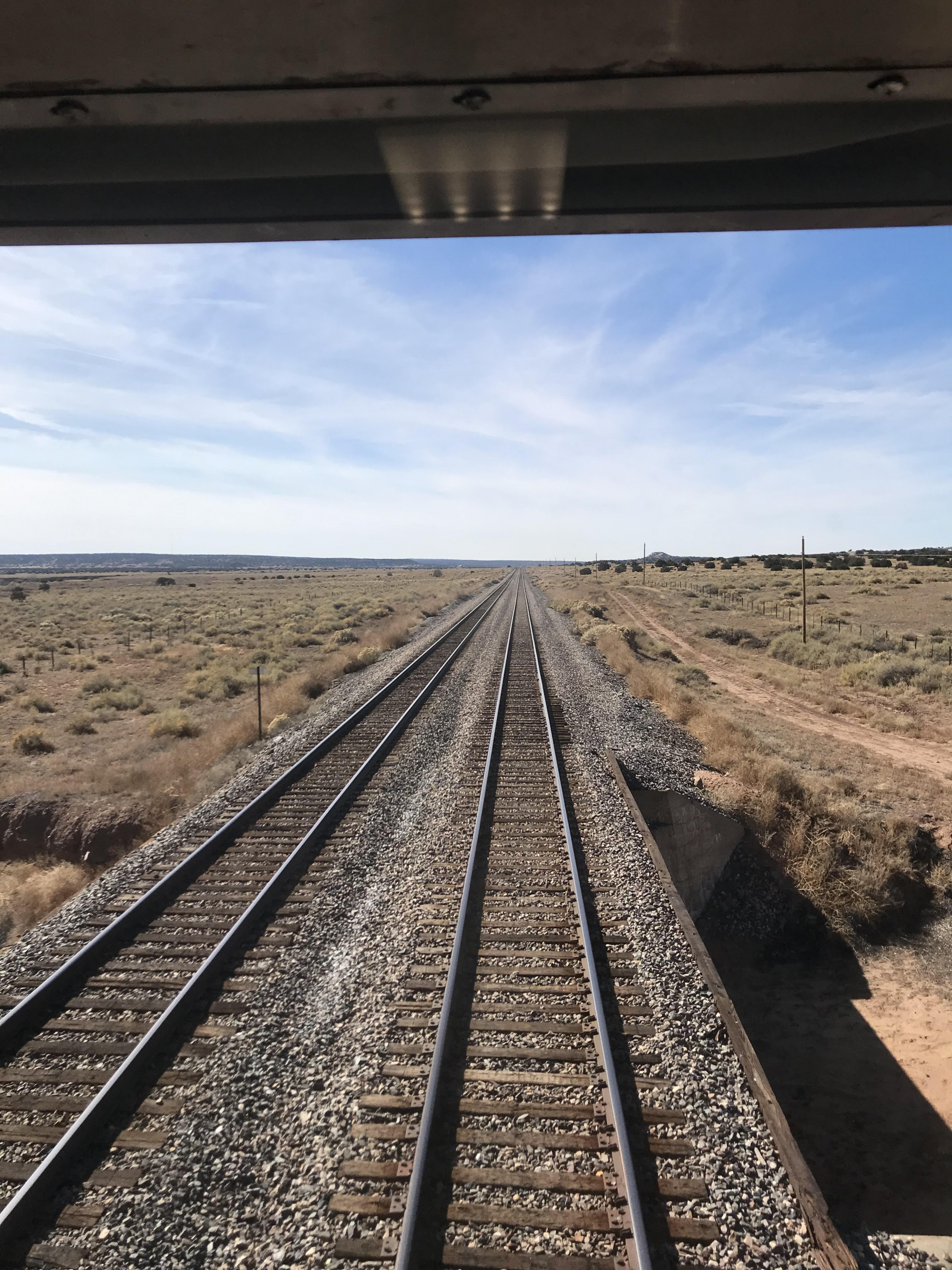
Getting Out of the Fast Lane: The Joys of Slow Motion
We should reexamine the degree to which we equate speed and rapid movement with “progress.” We should also give a leg up to slower travel modes – whether they be intercity trains, bikes or our own two feet – that may take a little longer but that can make us happier, healthier and more whole, while also reducing our impact on our communities and the environment.

“We are enslaved by speed and have all succumbed to the same insidious virus: Fast Life” –The Slow Food Manifesto
In 1986, an Italian food-lover named Carlo Petrini protested the opening of a McDonald’s restaurant near the Spanish Steps in Rome not by handing out leaflets, walking a picket line, or engaging in vandalism.
Instead, he did something even more radical. He handed out bowls of pasta.
Petrini’s initial protest grew into a global movement, one that challenged the rise of fast food by extolling the virtues of “Slow Food” — food rooted in local tradition, prepared carefully, and consumed with time to savor it.
Three decades later, at a time when even global fast food chains have come to talk the talk of the Slow Food movement, it can be difficult to remember a time when terms like “local,” “sustainable,” “clean” and “farm-to-table” were not part of our conversations about food.
Could it be time for a similar transition in how we talk about transportation? A “Slow Movement Movement,” perhaps?
On the face of it, such a notion seems absurd. To modern ears, transportation is about movement and speed – the more of each, the better. We have baked those preferences into public policy. We expect our transportation system to get us from Point A to Point B as quickly, cheaply and efficiently as possible. Isn’t that the entire name of the game?
A recent 1,000-mile train trip across the Southwest U.S., however, revealed a bit of what we lose in our never-ending quest for speed and efficiency.

The journey I took on the Amtrak Southwest Chief cost twice as much and took roughly 10 times as long as a flight from Los Angeles to Denver. But it also gave me a front row, picture-window seat from which to experience the scenic beauty of the American Southwest. The dining car meals and long spaces between stops created opportunities for conversation with other passengers – a small town hippie from Wisconsin, a retired couple from Nashville, a woman in the next row learning to speak Navajo, a forestry professor on his way home to Albuquerque. And in part because of the inherent transience of those encounters, the conversations got beyond small talk — train conversations, I’ve learned, go deep pretty quickly.
Beyond that, long-distance train trips put you back in touch with the actual act of travel. You physically feel the distance you are covering. You are part of an intimate, rolling community with a couple hundred random strangers, in a space with no televisions and no WiFi. One could say that a train journey is to air travel what a Slow Food meal is to Chicken McNuggets. The caloric intake – the number of miles traveled – may be the same, but the experience is far richer.
Slow movement isn’t limited to interstate travel. A bike is slower than a car, but the experience of riding a bike is far richer and more engaging than that of traveling through a city, town or countryside in a vehicle engineered to replace outside noise with SurroundSound stereo. Parts of a city that had felt mysterious, alien and maybe even a little scary when driving in a car suddenly become real and accessible at human scale on a bike.
The same is true of walking. This past summer, my son spent five weeks walking 500 miles across northern Spain on the Camino de Santiago. He could have seen the major sites along the route in a few days and used the remainder of his time to visit some other place. But he – and the hundreds of thousands of other people who walk the Camino each year – chose to take the slower route. To experience the countryside, cities and towns up close. To feel every step beneath their feet.
Slow movement has more than experiential benefits. When it comes to traffic crashes, for example, we know that speed kills. A 2018 International Transport Forum study of road safety in 10 countries was unequivocal:
An increase in mean speed was accompanied by a higher number of crashes and casualties. A decrease was associated with fewer crashes and casualties. In no case did an increase in mean speed coincide with fewer crashes or casualties.
Slow movement is good for the planet, too. Air travel is a significant and rising contributor to climate change. Slower travel, especially when done on foot, on a bike, or in small electric vehicles, on the other hand, produces a tiny fraction of the carbon pollution of driving.
Last but not least, slow movement creates a paradox – while a person on bike or on foot might travel at a slower speed than the driver of a Ferrari, in congested city traffic, they can sometimes get where they are going faster. And because small, slower vehicles take up relatively little space (and require less space between vehicles to allow for safe stopping), a city relying on slower travel can often move more people more quickly than if all those people were in cars. The 24,000 people who traverse the stretch of sidewalk outside New York’s Penn Station during the evening rush hour, for example, would take up more than 20 football fields worth of space if they were each in their own individual stationary vehicles – and even more space if they were in motion.[1] That’s a recipe for gridlock.
Yet, in public policy circles, speed rules and the fastest vehicle often wins. Cost-benefit analyses of transportation projects and analyses of the impacts of congestion routinely use economic estimates that assume that time spent in travel it is “lost” time that could otherwise be spent working or contributing to the economy. Our urban transportation systems are designed to maximize speed and capacity for vehicles, even at the cost of endangering those traveling by slower modes such as walking or biking.
To be fair, when slowness is the result of being stuck in traffic, the experience can be miserable. And there are many times when speed really is of the essence. When I needed to return home to Pittsburgh for a family emergency a couple of weeks ago, I was very grateful for convenient, frequent, affordable air travel. Fast travel has opened up a range of experiences and possibilities that people a couple of generations ago could not have even imagined. We shouldn’t take that for granted.
But research has long found that people do value time spent in travel, and that the quality of the travel experience matters for their well-being. A recent review of the subject by transportation researcher Patricia Mokhtarian found that, in addition to getting from place to place, travel provides people with “curiosity, adventure-seeking, independence, status, therapy, escape, information-seeking and exercise.” A quick look around at the proliferation of adventure vacations, yoga retreats and Peloton bikes suggests that these are services modern Americans value, and for which many are willing to pay big money.
We should reexamine the degree to which we equate speed and rapid movement with “progress.” We should also give a leg up to slower travel modes – whether they be intercity trains, bikes or our own two feet – that may take a little longer but that can make us happier, healthier and more whole, while also reducing our impact on our communities and the environment.
Doing so might require us to reevaluate how we live our lives – to create the space needed to allow us to travel more slowly and enjoyably. And it might require us to rethink how we organize our cities, to bring more people and places within range of a walk, bike or bus trip.
Yet, in many ways, we are doing the opposite. At the moment, for example, Amtrak is phasing down traditional dining service on some routes as a cost-cutting move (though, as with seemingly everything these days, the railroad has clothed it in “OK, Millennial” generation-clash rhetoric). Even the continued survival of iconic routes like the Southwest Chief is uncertain. Meanwhile, as a country, we continue to waste billions each year on boondoggle highway projects sold to us in the name of efficiency and speed, but that generally contribute to making us poorer, sicker, and more miserable than we would otherwise be.
Whether on a 1,000-mile train trip or at an “open streets” event, on a walking vacation or enjoying a pop-up parklet on “park(ing) day,” actions that challenge the primacy of speed in transportation open us up to traversing the places we live with the time to truly savor them, and perhaps even allow us to experience daily travel as a convivial joy rather than a nerve wracking, all-out competition to get somewhere as fast as possible.
Three decades ago, Carlo Petrini and his friends challenged us to eschew Fast Life. Where better to next examine the implications of Fast Life than by reexamining the way we travel.
[1] The math: Average footprint of a light-duty vehicle: 49.5 square feet (https://www.greencarcongress.com/2018/01/20180116-epa.html), average size of a football field, 1.32 acres (https://www.reference.com/sports-active-lifestyle/many-acres-football-field-a20196b5a2b4acc8). 24,000 pedestrians * 49.5 sq. ft. = 1,188,000 sq. ft. if in vehicles = 27.3 acres/1.32 acres per football field = 20.7 football fields.
Authors
Tony Dutzik
Associate Director and Senior Policy Analyst, Frontier Group
Tony Dutzik is associate director and senior policy analyst with Frontier Group. His research and ideas on climate, energy and transportation policy have helped shape public policy debates across the U.S., and have earned coverage in media outlets from the New York Times to National Public Radio. A former journalist, Tony lives and works in Boston.
